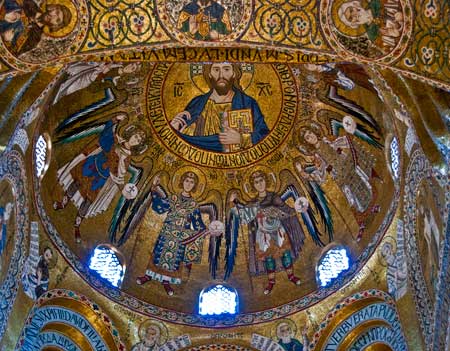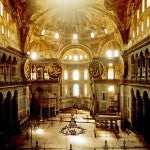In the previous entry, we talked about Early Christian architecture. All that would be transformed during the rule of Emperor Justinian I in the 4th century, when the architectural style of various structures changed drastically—including those of churches—as he started the campaign to assimilate Byzantine culture in the west.
The period marked a revolution in architecture, leaving its influence in the modern world through churches like the Hagia Sophia in Istanbul.
Here are some features of Byzantine architecture.
Multifaceted geometry
Pillars and walls have become bigger and thicker, adding to the overall durability of Byzantine churches.
Additionally, architects did not settle for stone, but also used bricks and plaster to make structures more robust.
The incorporation of mosaics
 Byzantine mosaic
Byzantine mosaic
Image source: Flickr
Although mosaics were used during the earlier periods of Christianity, it was during the Byzantine era that they were utilized extensively.
Massive domes covering the piers
 Image source: www.odysseyadventures.ca
Image source: www.odysseyadventures.ca
Perhaps the most recognizable feature of Byzantine churches are the domes covering the piers, right above the altar. Domes usually have windows and an opening in the middle to allow the light to pass, illuminating the altar where priests celebrate the Divine Liturgy.
Examples of Byzantine Churches:
Hagia Sophia, Istanbul, Turkey (537 AD)
 Image source: Istanbul Visions
Image source: Istanbul Visions
The most famous Byzantine church which once was the center of Eastern Christianity. It was later converted into an Imperial Mosque and now stands as a museum.
Basilica of San Vitale, Ravenna, Italy (527 AD)
 Image source: Wikipedia
Image source: Wikipedia
One of the most important centers of the Christian faith in Italy, construction of the Basilica of San Vitale was begun under the rule of the Ostrogoths and was then completed by the Bishop of Ravenna.
St. Mark’s Basilica, Venice, Italy (1093 AD)
 Image Source: A View on Cities
Image Source: A View on Cities
A cathedral church of the Roman Catholic Archdiocese of Venice, the Basilica of St. Mark is hailed to be one of the most superb examples of Italo-Byzantine architecture.
Chora Church, Istanbul, Turkey (CA 16th century AD)
 Image source: Istanbul Excursions
Image source: Istanbul Excursions
Considered one of the most beautiful surviving examples of Byzantine architecture, Chora was converted into a Mosque during the Ottoman reign.
Dome of the Rock, Jerusalem, Israel (641 AD)
 Image source: Marhaba
Image source: Marhaba
The Dome of the Rock is a temple-shrine located on the Temple Mount, considered Jerusalem’s most recognizable landmark. Although primarily built as an Islamic shrine, the builders took inspiration from Byzantine architecture.
As the Western Roman Empire fell, the influence of Byzantine culture went along with it. Hence, the architectural movement in the west shifted once again to a new direction through the Romanesque architectural movement, which incorporated several western elements and focused on accommodating more churchgoers.
In the next entry, we will discuss the Romanesque era and how it persisted in the Early Middle Ages.


